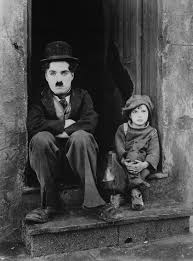Charlie Chaplin
Listen to the Recess! Clip
| Author | Kevin Shortsleeve |
| Air Date | 4/16/2002 |

Charlie Chaplin Transcript
At the height of the silent film era, cinema going could be a posh and stylish event. Filmgoers often wore their Sunday-best, and far from being truly silent, the best theaters of the 1920s employed entire orchestras bedecked in ducktails to provide the music.
Yet the most popular star of that fabled era of chandeliers and Dusinbergs was Charlie Chaplin – an actor, director and composer who devoted nearly the whole of his career portraying a downtrodden, poor and unlucky tramp. Staring out from the screen, pathetic and broke, the Tramp spoke to many about their immigrant heritage and what some interpreted as the elusiveness of the American dream.
Many today look at Chaplin from a distance and imagine that he was simply melodramatic. We forget how very funny his early films were – his cartoony antics and well-timed tumbles working like comic ballets – These were masterful and gleeful comedies.
In the early 1920s, Chaplin began looking for more serious roles. Where once he had produced two to three films a month, he now began a film that would take a year-and-half to complete. He called it The Kid, and it was about an orphan and the kindhearted lonely tramp who befriends him. This Oliver Twistian epic was destined to be one of Chaplin’s greatest statements as an artist. Critics note that ” A large part of [Chaplin’s] gift, was his ability to see life from a child like view point.” And many have suggested that in The Kid, Chaplin was depicting his own childhood in some ways. Born and raised in London, Chaplin had occasionally been placed in orphanages and even lived on the streets at times.
For whatever reason, The Kid, as Chaplin remembered it, was the only film of his that was unanimously praised. By 1924 it was playing in an astounding fifty countries – and Chaplin’s co-star, the child actor, Jackie Coogan, was even summoned for an audience with the Pope. Some have seen The Kid as a symbol of the orphans of the First World War. And critics have noted that in The Kid, Chaplin traces the injustice of a society to its ultimate and most vulnerable victim.
In the film, there is a dramatic chase in which the Tramp races over the rooftops in an effort to save the child. By placing his character in this position Chaplin was able to – as biographer David Robinson put it – take the “The absurd, waddling little figure” of the Tramp and elevate him “to heroic pathos.” As audiences, we have never been able to look at Chaplin in any other way since. He will always be the big-hearted unlucky vagabond,who, despite his faults, knows better than anyone else what is really most important in life.
Robinson, David. Chaplin: His Life and Art. New York: McGraw Hill, 1985.